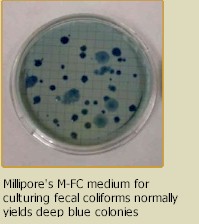|
BOB SIMONSON, Program Leader
QUANTIFYING FECAL COLIFORMS Kim Clarkin , Project Leader |
||

San Dimas Technology
& Development Center
444 E Bonita Ave
San Dimas, CA 91773
(909) 599-1267
| Incubators | QA/QC | Batteries & Inverters |
FECAL COLIFORMS
The test kit for fecal coliforms uses the membrane filtration method to process the water samples. Kit components include the sample filtration and incubation hardware and disposables, the incubator, and equipment for counting the colonies. The processing area must be protected from wind. The method requires use of an alcohol burner for equipment sterilization.
At this time (10/06) membrane filtration is the only EPA-approved method for enumerating fecal concentrations in ambient waters. The method is known as 9222D in Standard Methods (APHA 1998), and if a copy is available, Standard Methods is the best source for a full description of the procedure. It is available on the web only by subscription.
Another good source of information and references about this technique is the USGS Ohio Water Microbiology Laboratory website. It has up-to-date information on analytical methods, and references for USGS methods manuals available for download.
[Note: Standard Methods (APHA 1998) includes a delayed-incubation test for fecal coliforms (9222E). The test is to be used when samples cannot be immediately incubated. It involves placing the filtered sample on a holding medium (m-ST) for up to 3 days before continuing with the standard mFC procedure. This method would seem to be ideal for backcountry conditions, but unfortunately it is not on EPA’s list of approved methods, nor are we able to find a ready source for prepared and pre-measured m-ST medium.]
Brief description of membrane filtration method using mFC medium
Much of the equipment in the field kit is from the Hach Company’s Total Coliform Microbiology Environmental Laboratory (MEL/MF total coliform laboratory), currently selling for $2960. In addition to the equipment pictured above, the Hach MEL/MF lab includes an incubator Results from the fecal coliform membrane filtration tests How we conducted our testing This was a small project, and we were not able to do extensive testing comparing field results to results from a certified lab. We did do some testing, varying our test plan in response to problems we noted in the course of the project. Unfortunately, the data sets are too small to draw statistically sound conclusions. The important point is that you will need a good quality assurance/quality control plan of your own to produce reportable results in the field. In general, we compared results from at least five replications of split samples run at each of two to four test locations. Water was collected in a bucket and sterile Whirl-pak bags or sample bottles were filled from the bucket. A certified laboratory analyzed one set of 5 splits, another set was analyzed on site using the kit, and one was taken back to the water lab at SDTDC and analyzed there using the same kit equipment. In some cases, another set of splits was processed on the truck using the field kit, but several hours after leaving the field.

Some of the equipment used for membrane filtration.
![]() Key to pictured components:
Key to pictured components:
For more details on using the disposables in this kit, see tips



